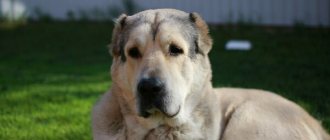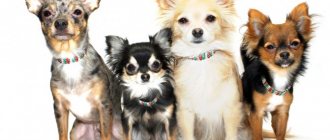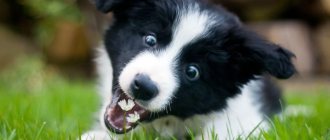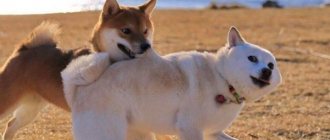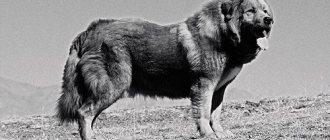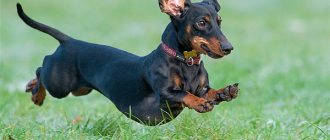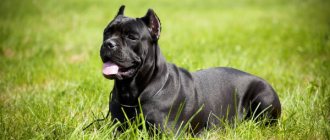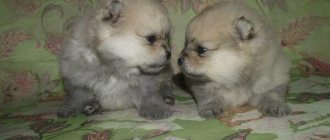Before you get a four-legged pet, you need to carefully study all the characteristics and features of the breed you are interested in. This is extremely important, since dogs have individual characters, sizes, habits, temperaments, preferences and much more. In our article we will talk about the Tibetan Mastiff breed, photos and pictures of which you can see below. This species belongs to the most ancient representatives of watchdogs and was used as an assistant in the protection of monasteries in Tibet and Nepal, and acted as a protector of nomadic families and their livestock from unwanted guests.
Origin story
There is no exact historical data regarding the origin of one of the largest dogs in the world - the Tibetan mastiff. Sources vary greatly in information and facts about the appearance of the breed, and are also embellished with various legends and myths. Some information says that their ancestors are black Himalayan wolves, while others claim that the genus of the Tibetan mastiff came from the guard dogs of Chinese traders who plied the mountains of Tibet. It is known for certain that the first written mentions of shaggy giants date back to 1121 BC. An entry in the Chinese chronicle Shu King says that mastiffs protected the homes of monks, temples and herds of domestic animals from the attacks of predatory snow leopards and from other, no less aggressive inhabitants of the mountains.
Myths and legends, as well as beautiful traditions, say that the first dogs of Tibet belonged to the Buddha himself and the brave Genghis Khan. Dog experts hypothesize that purebred varieties of Tibetan mastiffs are the ancestors of all current breeds of four-legged molossoid species, which includes such famous dogs as St. Bernards, shepherd dogs, Rottweilers, boxers, Great Danes, etc.
The first European notes about the shaggy giant were recorded in 1847. This year, the shaggy puppy was presented as a gift to the English monarch, Queen Victoria. Documented standards for the Tibetan Mastiff breed were recorded in writing in Europe by the Berlin Zoo only in 1898.
Representatives of this species are quite rare and expensive pets. Their value is due to the fact that they were able to preserve their appearance and characteristics almost in their original form. The inaccessible Himalayan mountain range protected the breed from external influence from the southern border, and from the northern border this function was performed by the desert. This contributed to the fact that the appearance of the animals remained original, unchanged and impressive.
Frequent illnesses and problems
Mastiffs are characterized by good health, but they are susceptible to certain diseases. The most common ones include:
- hip dysplasia;
- entropion of the eyelid;
- elbow dysplasia;
- osteochondrosis;
- hypertrophic neuropathy;
- panostitis;
- autoimmune hypothyroidism;
- rickets.
Many of these diseases can only be cured by surgery. For example, rickets begins at an early age and progresses. It is important for your puppy to have the right diet. To detect any problems in the early stages, it is recommended to take your puppy to the veterinarian.
It’s not enough to just want to own a Tibetan Mastiff – it’s important to understand the full responsibility of this step. You will need the ability to train and raise a dog; it is important to learn to cope with the difficult temperament and character of the breed. With the right investment of time and effort, this big bear will become a good friend and companion, a faithful and reliable guard.
Dogs can detect cancer and other diseases
If a person has cancer, diabetes, or epilepsy, his dog may be the first to know about it. Research has shown that dogs can be trained to detect cancer in a specific organ, such as the lung, breast, skin, bladder and prostate. Scientists believe that dogs can smell even the faintest smell of malignant tumors.
Dogs can memorize hundreds of words
The average dog is as trainable as a human child and can learn between 200 and 500 words. Moreover, the dog can learn the basics of mathematics, such as learning to count and order numbers in ascending order.
The largest dog that ever lived is the English Mastiff.
The English mastiff Zorba, born in 1981, was the largest dog in history. Its mass was more than 155 kg, and its length from the tip of its nose to the tip of its tail was 251.5 cm.
About the breed
The Tibetan Mastiff is a very large and strong dog with a well-developed muscular physique. Its peculiarity is a long and thick coat with abundant thick undercoat, which creates a kind of mane in the neck and forearm area. This trait gives the breed an amazing resemblance to lions; the animal looks menacing and angry. The dogs are very hardy, they tolerate both cold and hot days well, thanks to which they can safely live outside all year round. The weight of an adult individual ranges from 59 to 85 kg, reaching a height at the withers of 61 – 78 cm.
The characteristics of the Tibetan Mastiff allow it to be used as a companion, guard or even bodyguard. The dogs are smart and well trained, friendly and incredibly loyal to their owner. True, the animal will be able to perform its functions 100% only after reaching adulthood, for boys this is 2-3 years, girls mature only at 4 years. This species has excellent sexual characteristics - males are much larger than females.
Dog character
The Tibetan Mastiff's personality has been described as balanced, calm, gentle, friendly and patient. But this is inherent to him only if there are no irritants from outside. When the owner, family or home is threatened, the ability to make decisions, quick reactions and aggression are manifested. The Great Dane perfectly protects the territory entrusted to him and his household from any danger. The breed is one of the highly intelligent representatives of four-legged pets, this is a consequence of the fact that in Tibetan houses it was normal to leave the mastiff in charge of the elder, children and livestock were entrusted to them, the dog itself monitored the maintenance of order.
Dogs of this species perfectly understand their own self and are independent family members who require equal treatment and can sometimes refuse to obey. Along with this, they are very reserved and loyal, they get along well with other dogs and cats, if they are peaceful and do not show arrogance and anger. Tibetan Mastiffs are very warm towards children and can easily become excellent nannies. They are tolerant and perfectly understand their size: if a dog plays with a small child or a person with disabilities, then it will never make awkward movements that could cause injury.
If the pet is used exclusively for security purposes, then it is important to understand that its activity occurs more at night; during the day, shaggy household members are most often drowsy and inactive. It doesn’t have any negative characteristics as such, but everything is individual.
Breed standards
The standards of the Tibetan Mastiff are characterized by many breed indicators and descriptions, these are not only the correct proportions of the body and general appearance, but also temperamental characteristics, color, size and weight.
The main characteristics that define the breed:
- The head is massive, weighty and strong with a large skull, with folds from the tips of the eyes to the edges of the mouth. The frontal part is wide, a tubercle on the back of the head can be easily felt;
- Muzzle with a square end and a blunt edge;
- Powerful jaws with a perfect scissor bite and well-defined lips that completely cover the lower row of teeth;
- The eyes are dark brown, medium-sized, oval-shaped, widely spaced closer to the edges of the head;
- The ears are hanging, medium in size, triangle shaped, slightly covered with soft down. In case of anxiety, they rise;
- The neck has an arched shape, strong structure, with a small dewlap. It is characterized by a long and dense mane-like coat;
- The back is level, the body is large with a well-developed muscular system and a wide, egg-shaped chest;
- The tail is of medium size, lush, smoothly transitions from the dorsal line, has a right or left curl with a beautiful long pile;
- The paws are proportional to the body, massive, and have a regular, even shape.
Weight by month
As mentioned above, in the description of the Tibetan Mastiff breed, dogs do not mature quickly and reach maturity only by 3–4 years. Newborn puppies are born bald with a weight of 400-500 grams, then in the first month of life they gain up to 5 kg and continue at this rate right up to the fourth month, respectively 11 kg for the second month, 15-16 kg for the third and 17-18 kg. fourth. Then there is a weight jump of as much as 7-8 kg and at 5 months the Tibetan Mastiff puppy already weighs 24-25 kg. Over the next seven months, the baby adds 3-4 kg to his body weight and by the age of one year he already weighs 41-44 kg. Every six months following, the four-legged miracle increases by another 5 kg and at two years of age reaches 53-54 kg, respectively. Depending on the feeding ration, each subsequent year the dog gains another 3-4.5 kg and at the peak of its development weighs about 60 kg.
Maximum height and weight
Some specimens of an adult Tibetan mastiff can reach a weight of 88-90 kg and have a height at the withers of up to 80-85 cm.
The largest and most expensive
The Tibetan Mastiff breed is one of the largest in the world and its largest representative, as well as the most famous and expensive, is a male named Big Splash, originally from China. His weight is truly impressive and equals 113 kg. This red baby at 11 months of age already weighed as much as 80 kg. He is also the most valuable dog on the planet and cost his owner $1.5 million. The diet of this pet includes the best varieties of chicken and beef meat, as well as exclusive seafood, which pays off handsomely, since mating with this giant costs more than 15 thousand dollars and the queue for it is impressive.
To what age do they grow?
Tibetan Mastiffs are a type of breed that matures quite slowly . For this reason, you need to carefully monitor their growth in order to notice any deviations.
The intensive growth stage in mastiffs lasts up to one year. Further growth may slow down and become almost unnoticeable, but this does not mean that the process has frozen in place.
You can watch your Mastiff go through certain stages of growth.
In the spring, shedding begins and dogs consume less food . In the fall, the cold causes mastiffs to grow hair and consume more food. During this period they grow faster.
NOTE!
Full maturation in a female Tibetan mastiff occurs 3-4 years after birth.
Males mature one and a half years longer . Moreover, the maturation of mastiffs can be accompanied by intensive growth of one of the body parts, for example, the head or tail. This is a normal phenomenon; over time, the dog’s physique will become harmonious.
Appearance from photo
As stated above, this is a huge and muscular breed. Pupils of the Tibetan Mastiff, whose height at the withers reaches 68-78 cm, have a luxurious, voluminous, thick coat with a warm undercoat, which can be seen in the photographs and pictures below.
Coat type and color
The coat of this type of mastiff is unique in its appearance and composition - an abundant elongated pile with a very thick undercoat allows the animals to feel good in the harshest winter conditions, they sleep peacefully in the snow and tolerate icy mountain winds well. As described above, in the neck area the hair has a special length and visually resembles the mane of a lion.
The color of Tibetans is varied and is represented by the following options:
- Black;
- Ginger;
- Brown with iridescence;
- Golden;
- Red;
- Fiery;
- Fiery red;
- Red-orange;
- Chestnut, different shades of gray and blue.
There may also be combined colors with tan inserts in the eye area, on the tip of the tail and all paws.
Is there such a thing as white?
A very rare occurrence is the birth of a white mastiff puppy, which you can see in the photo below. Due to the enormous difficulty of breeding this color, white color is not accepted as a standard. The white Tibetan is a very expensive dog, it looks gorgeous, its cost is estimated at 1 million dollars or more.
Coat
For the Tibetan Mastiff, the quality of the hairs is more important than their quantity. Bitches have fewer of them than males. The outer coat of medium length consists of an undercoat (dense, rather thick) and guard hairs (thin, sticking out, hard to the touch). The coat should not have any waves or curls. Also, it cannot be silky and soft to the touch.
A luxurious mane, similar to a lion's, abundantly covers the neck and shoulders of the Tibetan Mastiff. The animal's tail is well furred. The upper part of the hind legs is covered with a kind of “pants”.
Proper care and maintenance
Caring for furry babies and big giants is no different from caring for standard dogs, but requires some nuances, which will be discussed. You can keep such red babies nearby both indoors and outdoors, but the second option is most preferable.
Shedding
Tibetan mastiffs do not shed frequently; this phenomenon occurs once every 365 days. In some natural zones, molting is completely absent. But when the shedding period begins, the hair falls out in clumps, which is a feature of the breed. Despite this, caring for your pet’s fur is quite simple. Caring for them can be compared to caring for shaggy German Shepherds. You only need to comb the soft undercoat a couple of times a week and give vitamins for the lint. As soon as the shedding has passed, fur care is reduced to once every seven days.
Contents of the Tibetan Mastiff
Tibetan Mastiffs are dogs that require close attention, as well as compliance with a number of rules that will help maintain the physical and mental health of your pet. This series of rules includes the organization of a healthy diet, and most importantly, a balanced diet in terms of nutritional components, as well as the organization of physical activity, etc. This breed can be kept both in an apartment or a house, but also on the street, in the open air.
Care and hygiene
Since the pride of the Tibetan Mastiff is its thick coat, it requires careful care, especially during periods of shedding. It is equally important to take care of the animal’s eyes, ears, teeth and claws. That's why:
- During periods of shedding, you will have to comb the animal's fur 3 times a day.
- You will have to bathe your dog about 2 times a year.
- If tangles appear, the latter must be carefully cut out using scissors.
- You will have to brush the animal’s teeth a couple of times a week, as well as monitor the process of changing teeth and the general condition of the gums.
- Nails are trimmed twice a month with a special nail clipper.
- When returning from a walk, the animal needs to thoroughly wash its paws.
- The ears are inspected and wiped with damp sanitary wipes.
- The eyes are washed from time to time with an infusion of medicinal chamomile.
Interesting to know! To choose a worthy pair for your pet, it is advisable to contact nurseries that practice breeding a similar breed. This will not cause deviations in breed standards and will contribute to the further development of the breed.
It is also necessary to know that this breed matures relatively late, so individuals older than 4 years should be bred.
What to feed
The well-being of the Tibetan mastiff and its longevity depend directly on proper feeding of the animal. In this case, the animal can be fed both natural food and ready-made dry food. As a rule, mixing these two types of nutrition is strictly not recommended.
As experts recommend, it is better to give preference to natural food. A puppy under 2 months of age is fed 6 times a day, distributing food proportionally. The main types of foods that can be fed to a mastiff include:
- Lean meat, such as turkey or beef.
- By-products must be thermally processed.
- Fermented milk products, in the form of kefir, cottage cheese or acidophilus mixture.
- Cereals such as rice or buckwheat.
- Boiled eggs, no more than 2 per week.
- Boiled vegetables such as carrots, cabbage or pumpkin.
- Fresh fruit, including apples.
- Vegetable oil of any origin.
- Dried fruits, cheese and raisins are used to encourage the training process.
- Various greens.
You need to know this! The animal's daily food intake is about 4 percent of the animal's weight.
To balance the diet, vitamin and mineral complexes should be added to the food. Their use must be agreed with a specialist. From 2 months to 6 months of age, the animal is fed 5 times a day. At the same time, you can introduce boiled fish into your diet, removing the bones from it.
Diseases and breed defects
The Tibetan Mastiff breed is susceptible to a number of infectious diseases. For example:
- Nervous plague.
- Parvovirus enteritis.
- Rabies.
- Infectious hepatitis.
If you get the necessary vaccinations in a timely manner, you will be able to protect your animal from many dangerous ailments by protecting its immunity. Diseases associated with the characteristics of the breed are: hip dysplasia, malignant neoplasms and allergies. This can also include osteochondritis, bone dystrophy and dermatitis. Any deviation from accepted breed standards is associated with deficiencies, and their degree depends on the level of possible deficiencies.
Breed defects are associated with manifestations of various inconsistencies, not only of a physical nature. For example:
- Light or excessively wrinkled scalp.
- Saggy lips.
- The presence of a clearly visible suspension.
- Large or not too high set ears.
- The eyes are light with a wide open look.
- The nose is not brightly colored enough.
- Barrel-shaped rib part of the body.
- The tail is curled tightly at the hip area.
- Heavy and too constrained movements.
- Short stature beyond established standards.
Overly aggressive or overly indecisive individuals, or with an incorrect bite, are not allowed to be shown. The same applies to dogs that have a non-standard body color. Dogs with obvious breed deviations from the standards are also subject to exclusion.
Education and training
A dog of this breed needs early, mandatory education, which is associated with adaptation processes. Animal training is related to:
- With mandatory socialization.
- With imprinting.
- With the study of a mandatory training course.
The course of socialization and raising a puppy is associated with possible difficulties, since the puppy often shows stubbornness and aggression. This is due to the peculiarities of the animal’s behavior, due to the mastiffs’ sense of self-esteem.
Important to remember! After the imprinting course has been mastered, you should begin the stage of socialization of the animal. This stage is associated with the animal learning to adequately respond to the world around it and to human society. A socialized animal can easily learn the entire course of basic training and commands.
Imprinting is the process by which a dog begins to trust its owner. Such training, associated with the first stage of education, teaches the dog to react correctly to surrounding events, including to humans.
Tibetan Mastiff #1.// Ideal dog. The best watchman.
Breeding: heat, how many puppies does she give birth to?
The first menstrual cycle in a female dog occurs at eight months of age and is repeated once a year, most often in late autumn. The animal's immunity weakens, and it requires special attention and care: the fur should not be allowed to get wet and hypothermia. The first mating can be done only at more than two years of age. The gestation period usually lasts between 54 and 66 days. At this time, the dog is especially aggressive and only allows its owners to approach it. Childbirth is slow. In one litter, the bitch produces offspring of 5-12 cubs, which are born almost bald.
Can you keep it on a chain?
Under no circumstances should this breed be kept on a leash. Constant keeping in an enclosure is also contraindicated; it should be closed there only when absolutely necessary, when strangers are in the house. The cage for the Tibetan Mastiff is made spacious and strong; it is not recommended to install a thin wire mesh or chain link.
If a Tibetan dog is left to roam in the yard, the fencing system should be of an appropriate height.
Frame
The powerful body of a dog of this breed consists of a muscular back and a straight line of the spine. The croup is voluminous, flat in shape. The deep chest of medium volume reaches the elbow joints, the bend of the compressed ribs resembles the shape of a heart. The body length of the Tibetan Mastiff is slightly longer than its height.
The Tibetan Mastiff's tail is of medium length and high set. It is located at the level of the straight line of the spine. When alert or excited, the animal raises its tail quite high, easily throwing it over its back.
How many times should I wash and comb?
Bathing procedures for the Tibetan Mastiff should be carried out as needed, but it is recommended at least once a quarter. This is explained by the fact that despite the dense wool, household members of this breed practically do not have any unpleasant odor. After washing, the animal must be combed and dried with a hairdryer, the air flow of which must be directed against the growth of the pile. This is necessary in order to achieve maximum fur fluffiness. Tibetans are combed one to three times a week, depending on the condition of the coat.
How to cut your hair?
There are no special features of the haircut process. A hygienic haircut is desirable, but not required. It is needed when there are fur tangles in the wool that cannot be sorted out or combed out. Decorative or seasonal haircuts are carried out solely at the discretion of the owners. The only requirement is not to cut the hair too short, as the animal may catch a cold and get pneumonia. Ideas for haircuts for Tibetan dogs can be found in photos in pet catalogs or animal hairdressing salons.
Which is better: natural or dry food?
First of all, you need to know that at first you need to feed the puppy what the breeder gave him.
In the future, the choice of food is up to you, but both natural and artificial food have their own disadvantages and advantages:
- Natural food contains natural vitamins and minerals. You will know exactly what you are feeding your pet. But such cooking requires a lot of time, moreover, you must create a properly and balanced menu so that the dog receives all the necessary nutrients.
- Artificial food immediately contains all the vitamins necessary for a dog’s health; no additives are needed. Another thing is that you cannot be sure whether the composition on the package matches the contents. Also, the use of industrial feed is not time-consuming.
Thus, the owner must choose for himself which food is optimal for his dog, weighing all the pros and cons.
Owners of Tibetan Mastiffs
most often use natural dog food .
Expert opinion
Kozhevin Semyon Kirillovich
Expert dog handler.
“Our nursery has always used only natural food for this breed. It’s hard to imagine feeding Tibetan mastiffs artificially. This breed requires a careful and individual approach; you cannot buy such an “approach” in a store. Some puppies need more food, some less, plus vitamins, because raising such a breed is not at all easy. Keeping a mastiff for fun will not work, nor will feeding it store-bought food.”
Training and education
Tibetan Mastiffs and humans get along well, but the breed is sometimes difficult to train at home. Expert breeders recommend sending puppies to canine centers to undergo an obedience course. Training begins with mastering simple commands, such as “Ugh!”, “Lie down!”, “Come to me!”, “Near!” etc. In the first year of life, skills are trained according to commands, and in subsequent years they are consolidated and endurance is developed.
A Tibetan is a student who requires respectful treatment, and not just giving commands. First of all, he is a friend, not a servant, and it is important to understand this.
Pros and cons of the breed
- excellent watchdog and security qualities;
- peacefulness, friendliness;
- good adaptation to all conditions;
- unpretentiousness in nutrition;
- easy care.
- not adapted to life in cramped apartments;
- heavy shedding;
- increased salivation;
- volume;
- stubbornness.
You can combat the disadvantages of the Tibetan from early childhood, so there won’t be any special problems with puppies.
Health and life expectancy
Shaggy fire giants are naturally endowed with excellent health and long life. The average lifespan of a four-legged pet ranges from 13-15 years, but there are also long-livers, albeit under proper living conditions. Due to their large size, dogs are prone to ailments of the paw joints, so an annual X-ray examination is recommended.
Diseases of the breed
As mentioned above, animals of this breed are distinguished by endurance and good health, but still, like all living beings, they are characterized by some diseases:
- Dysplasia of the pelvic and hip joints;
- Allergic reactions;
- Diseases of weak bones and bone tissue;
- Malignant tumors;
- Dermatitis and osteochondritis;
- Rabies, plague and hepatitis of infectious origin.
Timely vaccination will avoid most illnesses and protect the giant’s immune system for many years.
Important! Systematically take your household member to the veterinary clinic for a routine medical examination and the doctor will always be able to identify early symptoms of disease and prescribe adequate and timely treatment.
Diet and feeding rules
In order for your four-legged friend to lead an active lifestyle and feel good, you need to properly organize his nutrition. This breed of dog is not at all picky about food and eats relatively little.
For purebred puppies, an excellent diet will be beef or horse meat, raw and boiled, heat-treated offal, vegetables, a variety of cereals, milk and fermented milk products (cheeses, kefir, cheese).
Adults are fed beef and veal, seafood, bird eggs and the same set of products that are used for puppies.
It is necessary to ensure that the animal always has clean water and food includes the required amount of vitamins and microelements. If you use food, then choose only trusted manufacturers and those that are specifically intended for the Tibetan Mastiff breed.
Limbs
The straight forelimbs have an ideal angle of articulation, that is, the elbow joints are not turned in different directions. Forearms are straight. Powerful pasterns should have a slight slope.
The hindquarters are well-muscled, with well-bent knees and powerful, low hocks. If you look at the hind legs from behind, you can see that they are parallel to each other. The thighs are of moderate length and well developed.
The compact, rather long paws of the Tibetan Mastiff should be round in shape and with slightly curved toes. According to the standard, dogs of this breed are allowed dewclaws.
Breeders' advice for buying a puppy
Buying a puppy is a very serious step that needs to be approached with full responsibility. You need to choose a baby endowed with excellent physical health. If you don’t have any special wishes for external characteristics, then buy the fastest, most well-fed and strong puppy from the litter. It is important to understand that female individuals will be much smaller than male representatives. The color can be chosen from personal preferences; the color range is represented by a wide choice, from red to gray and even blue shades.
A Tibetan Mastiff puppy, endowed with all the attributes of the breed, must have thick and at the same time fluffy hair with an excellent layer of undercoat. The purchased baby must have clear and healthy eyes, with no signs of illness or disease.
Nicknames for boys and girls: what to call
The very name “Tibetan Mastiff” emanates oriental notes, and therefore nicknames with an oriental slant are more suitable for representatives of this breed. But still, the owner himself gives the name to his pet, relying entirely on his own discretion; there are no clear rules in this matter. For those who are scratching their heads and don’t know what to name their household, we have selected the following lists of names:
For boys: Weiming, Liu, Bingwei, Enlei, Guangli, Cheng, Rong, Zen, Bei, Xin, Kiang, Shining; For girls: Yanlin, Zhu, Ting, Lijuan, Luli, Yubi, Rou, Peizhi, Bo, Meili, Shihong, Tao, Bao, Chuntao.
Nutrition
Mixed food for this breed is strictly prohibited. If the owner’s choice is dry food, premium or super-premium, holistic is preferable. When feeding natural foods, give preference to the following products:
- lean meat (chicken, rabbit, turkey, beef);
- cereals (buckwheat and rice);
- quail eggs;
- fermented milk products (cottage cheese, kefir);
- vegetables and greens.
Mastiffs should not be fed sweets, flour, potatoes, smoked meats or salty foods. It is also not recommended to feed your pet from your table. Be sure to add minerals and vitamins. It is important to emphasize foods containing calcium - this is important for the prevention of rickets.
How much does a puppy cost?
As mentioned above, puppies of the Tibetan Mastiff breed are today the highest paid dogs in the world and not everyone can afford to buy one. In each country, the price of a baby varies and depends on many indicators. So they are the most valuable in their homeland; in China, such a purebred miracle costs from 25 to 35 thousand dollars. The European price tag falls much lower and reaches 1-5 thousand dollars. The Russian price range ranges from 40-160 thousand rubles per crumb. In any country, breeders are willing to pay fabulous sums for a rare specimen. Thus, the most expensive exclusive Tibetan Mastiff puppies cost about 1.5 million dollars and more.
Historical reference
By the most conservative standards, the age of the breed group reaches 4.5 thousand years. Dogs similar to Tibetan Mastiffs are mentioned in one of the five Chinese scriptures. The first authoritative mentions of giant dogs, and very flattering ones at that, were left by Aristotle
The Italian traveler Marco Polo also gave generous attention to the breed, who described the Tibetan mastiffs in his work “The Book of the Diversity of the World”
The remoteness of the region meant that Europeans did not see Tibetan Mastiffs until the 18th century. Exaggerations in the records of historians have led to the breed becoming something of a mythical creature. There were legends about the four-legged creatures, like Bigfoot and dragons.
More recent historical information notes that a dog of the Tibetan Mastiff breed was in the personal kennel of the ruler of Great Britain, Maria Alexandrina Victoria (1847). Edward VII, who ruled England (since 1901), also acquired giants, although he had to buy dogs, and Victoria was given a puppy. It is interesting that such a huge period of time did not affect the description of the breed... although, if you dig deeper and think logically, everything is obvious.
Tibet is a territory surrounded by mountains - forests, plains, unearthly beauty...snow, wild cold, thin air and unpredictable climate. Few people will willingly agree to live in such extreme conditions. Everyone knows that Tibet has its own population, religion, values, and the whole region is, as it were, cut off from the world.
Not only were mastiffs unknown to the world on a territorial basis, but the Tibetans were not particularly famous for their hospitality. The breed remained concentrated in one area and remained “invisible,” which preserved its purity. By comparison, quadrupeds living closer to sea level were seen by nomads and traders. Naturally, exports and interbreed matings “overtook” the more affordable dogs.
The modern dog breed Tibetan Mastiff is considered as a guard dog. If we return to the records of Marco Polo, one can doubt the purpose of dogs. The naturalist wrote that dogs helped hunt lions and giant wild bulls. Since there are no lions in Tibet, we can assume that they were talking about tigers. Wild bulls are most likely buffaloes, which were protected by dogs from the same tigers. As a result, the Tibetan Mastiff could be used as a guard and herding dog, but not as a hunting dog.
It's time to debunk the myths that abound in the history of the breed, at least some of them:
The Tibetan Mastiff is not the progenitor of all Molossians existing today. The viability of this statement is not excluded, but it has no evidence.
A cruel temper is the result of upbringing, and not a breed trait. The first representatives of the clan were described as strong in spirit and body, but not cruel or bloodthirsty.
Dogs are not inclined to kill people, although this is exactly the tactic they were trained to guard monasteries in Tibet. Any impudent person who desecrated the secrets of the monks, a thief or a “curious barbarian” was punished by death.
Mastiffs are slow - in fact, the speed and agility of these dogs can be envied. Four-legged animals are incapable of a long, exhausting chase, but again, if the dog decides to catch up with the runaway, it will do it.
Tibetan Mastiff in the modern world
Unfortunately, the majestic breed is in critical condition. After the economic collapse of Tibet, all dogs were destroyed or died of starvation. The king of Nepal became the saving straw, taking the four-legged animals under his wing. The country developed a program to save the breed; in addition, the Tibetan Mastiff was actively advertised to Europeans.
The engine of progress was an American, Anna Roar. The breeder brought dogs from Nepal, began breeding them, and initiated the founding of a breed club in the USA. Following the Americans, breeding of Tibetan mastiffs began in England, Germany and France. By the way, the largest population is registered (almost 200 dogs as of 2015) in France.
There can be no talk of free or mass sale of puppies. The dogs that survived in Tibet did not receive enough attention (to the purity of blood) and were raised for generations as tough, ferocious guards. Purebred livestock, gradually increasing in England, France, Germany and Russia, have a more stable psyche, but are sold strictly for breeding.
Owner reviews
Having studied the reviews of breeders and canine breeders of furry giants, it turned out that most of them are inclined to the following conclusions:
- Natives of the breed are characterized by excessive distrust of strangers and the absence of any aggression towards their family members;
- They are characterized by restraint, poise, high intelligence, calmness and the ability to protect the objects entrusted to them and their owners;
- The shaggy giant is moderately evil and uses aggression in exceptional situations;
- Such animals do not attack without certain reasons; they are quite friendly with children, as well as with other four-legged household members;
- They can become everyone's favorites in both small and large families.
No negative qualities have been noticed in these dogs, except perhaps excessive stubbornness, and this disappears with proper upbringing.
Interesting to know! The Tibetan Mastiff is not just a guard dog, it is a friend and a full-fledged family member who participates in all household chores and perfectly captures the mood of each member of the household.
Application
Obviously, given the impressive size of the mastiff, it will create many problems when kept in cramped city apartments.
His patrimony is a large country house with a spacious plot.
If you are interested in other breeds that are suitable for guarding a private home, we recommend reading the article
In public life, dogs are used, like Hovawarts and Groenendaels , for patrolling and guarding objects.
They are good companions for walking together.
These excellent guard dogs accompanied the Roman legions on campaigns.
